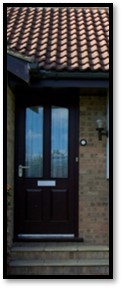Exterior Doors – Part 2

In Part 1 of this post, I discussed how to maintain exterior doors to avoid repair. You can read that here! Sometimes, despite our best efforts or a lack there of, we need to make repairs. In this post, I’ll break it down by repair size and replacement amount.
- Small repairs: If the damage is only just starting with minimal wood rot, then wood repair is a good option. With a sharp chisel carefully remove damaged wood until you see only clean solid wood. Purchase a two-part epoxy wood filler for best results. Using the wood filler, fill the depression and if possible, with first application, overfill so that the filler is higher than the surrounding surface. (If you still have a depression in the surface after it dries then you need to apply more wood epoxy). It will dry in less than 30 minutes at which point you can begin to shape and smooth with a putty knife. When it hardens too much for the shaping (and it won’t take long), then switch to 120 grit sandpaper and sand the surface flush with the original wood surface. When you have it ready, then paint to match.
- Larger repairs: Sometimes too much of the brickmold is damaged to repair. With the brickmold you can cut out the damaged part and splice a short piece of PVC brickmold in its place.
- Replace the door frame: Sometimes the door frame has rotted all the way through to the inside of the door. This is a bigger problem which requires a bigger solution. If you have the correct door frame side to match, then you can cut out and replace the damaged piece much like replacing the brickmold piece. If too much it rotten then you can also replace the whole side(leg) of the rotten door frame. That makes for the neatest looking job. It however, requires a higher skill set and more specialized tools and, in most cases, best left to the professional.
- Replace the whole door: Sometimes things are so far gone, that the best solution is to start over with a new door. If that is the case, then consider getting a new door with the composite frame. There is no wood in the frame nor the trim. It is all composite construction. There is now no worry of it rotting…ever. Typically, these doors are more expensive but may warrant the extra cost in saved time and maintenance over the long term.
When maintained properly, exterior doors help keep your house warm in the cool months, cool in the warm months and your energy bills in check. It can be a project that fits into the DIY category, but sometimes requires some a professional. Contact us at DCI if you need help!
The links to external sites in this post are affiliate links, and we will be compensated when you make a purchase by clicking through our links.

